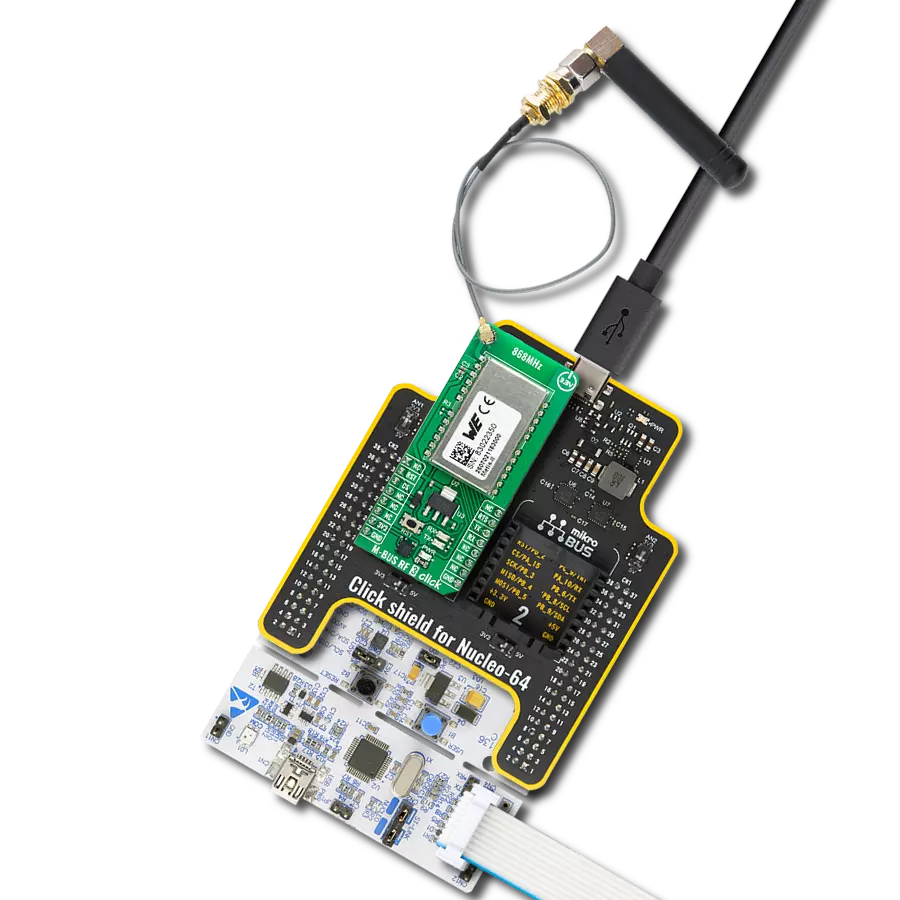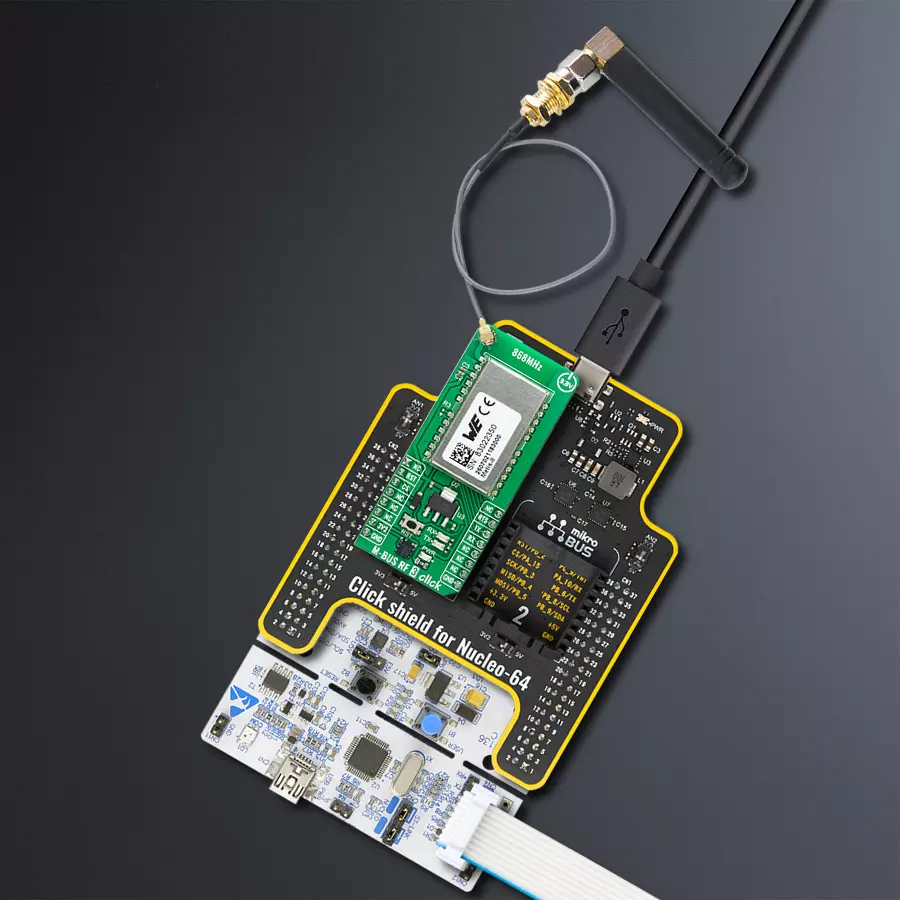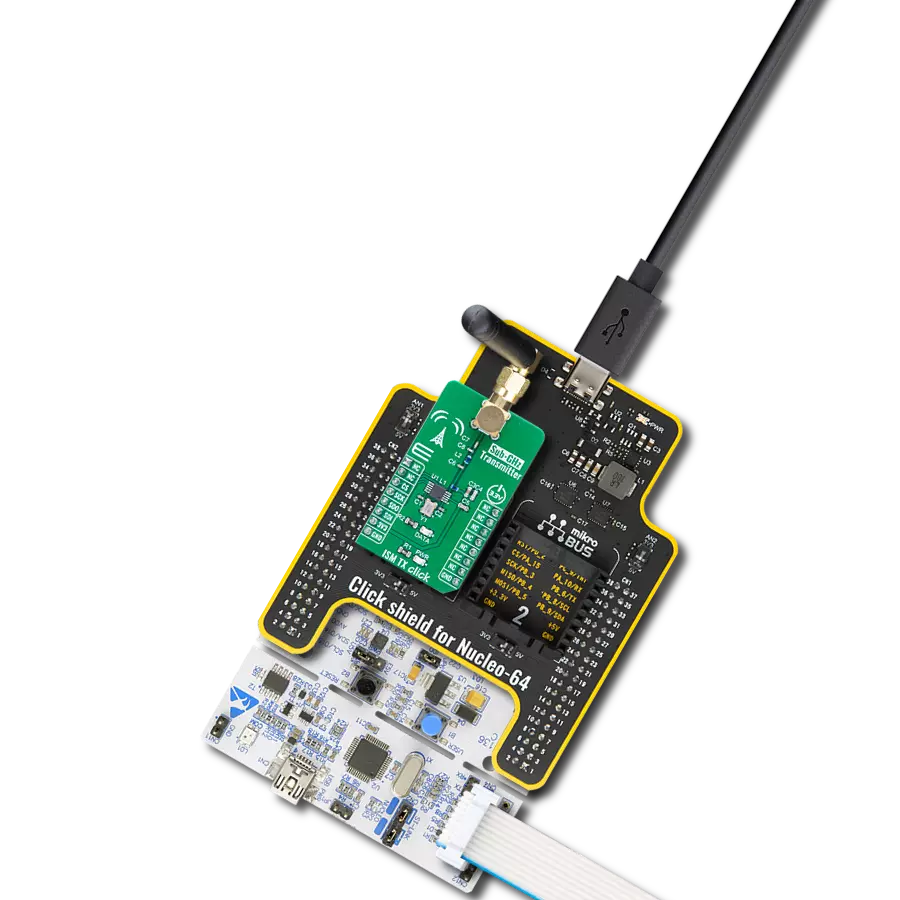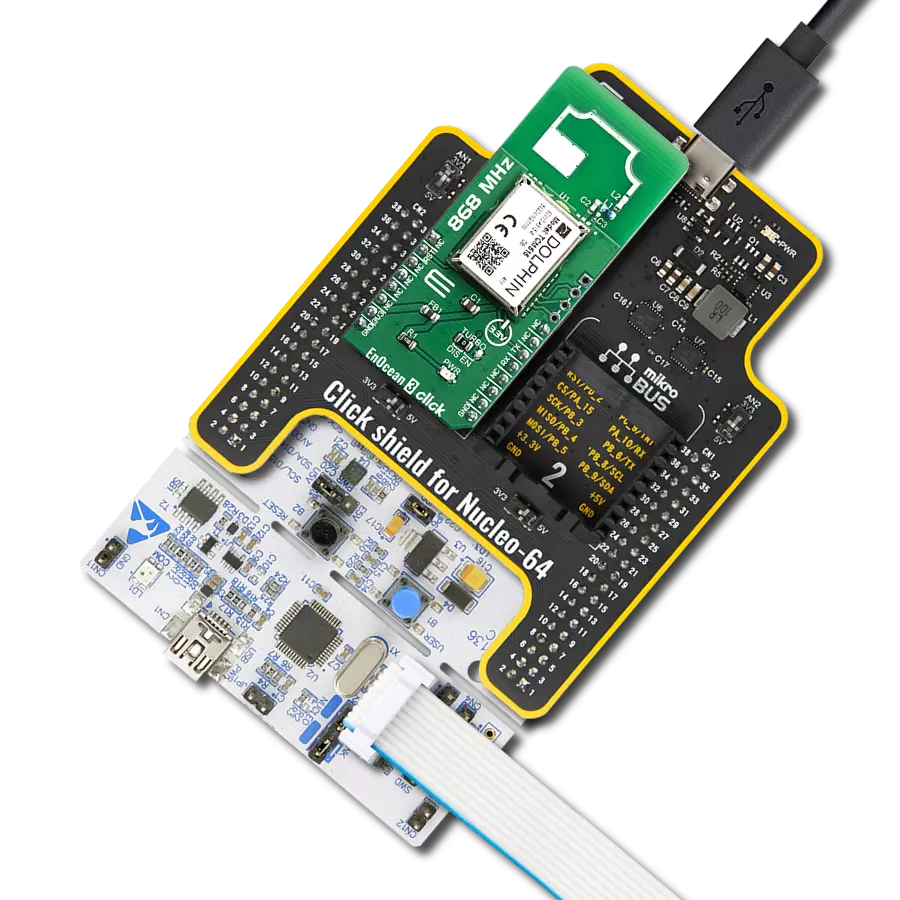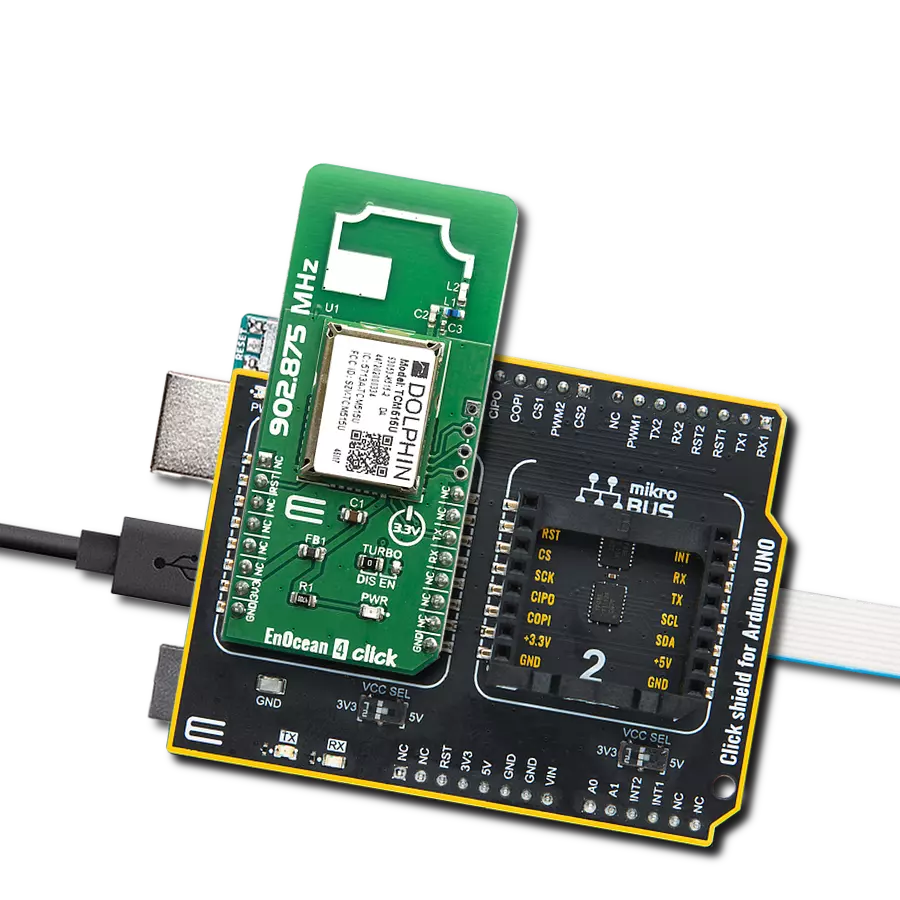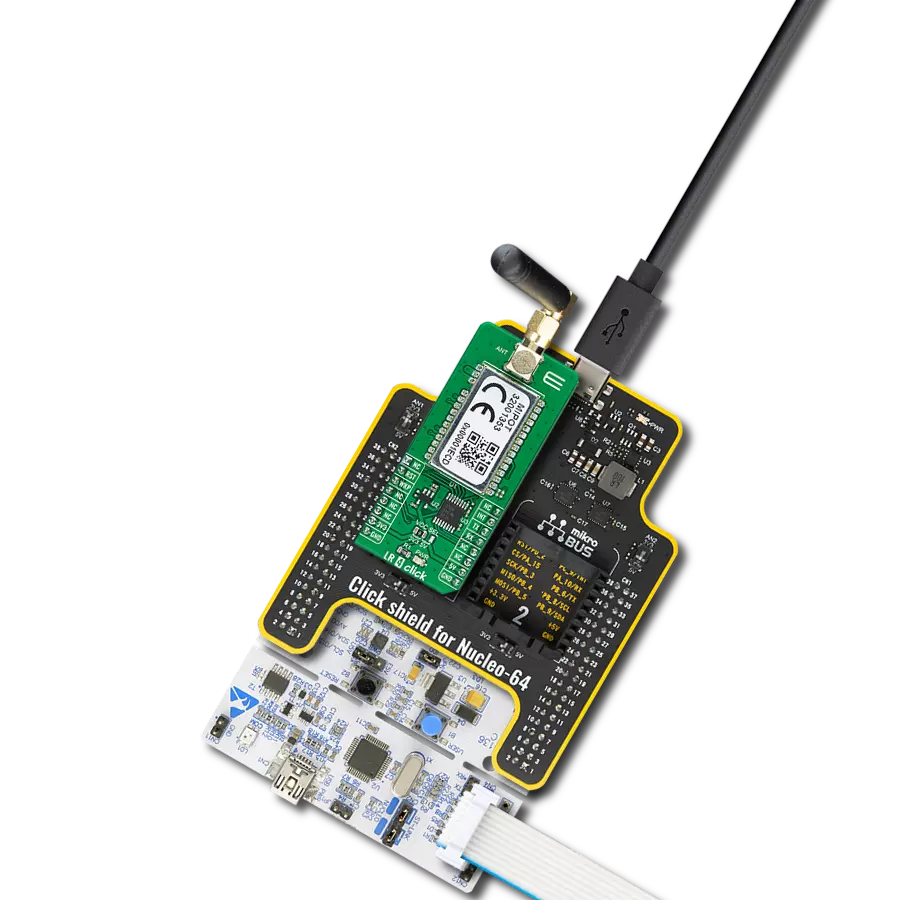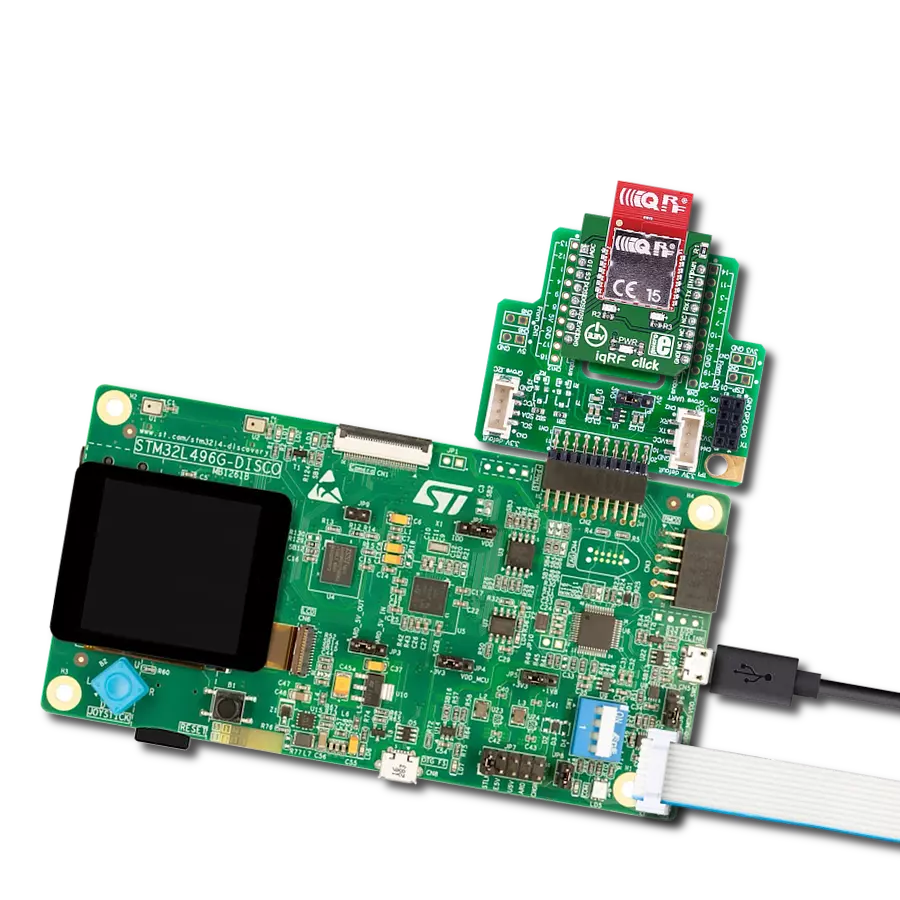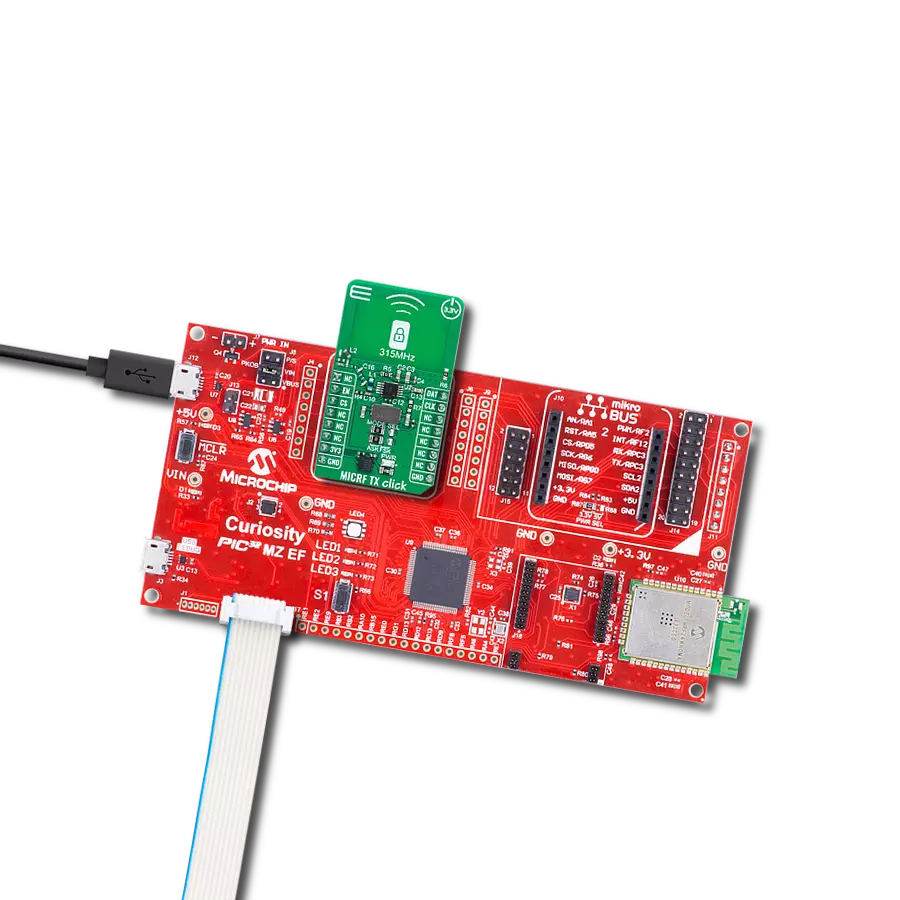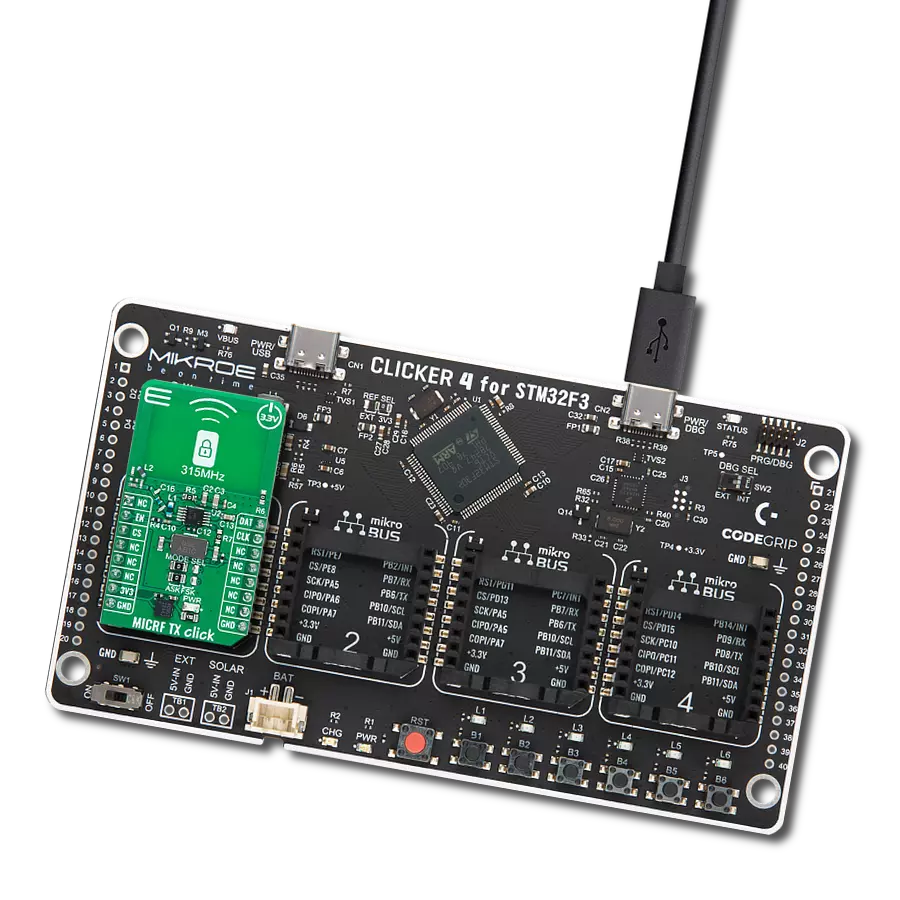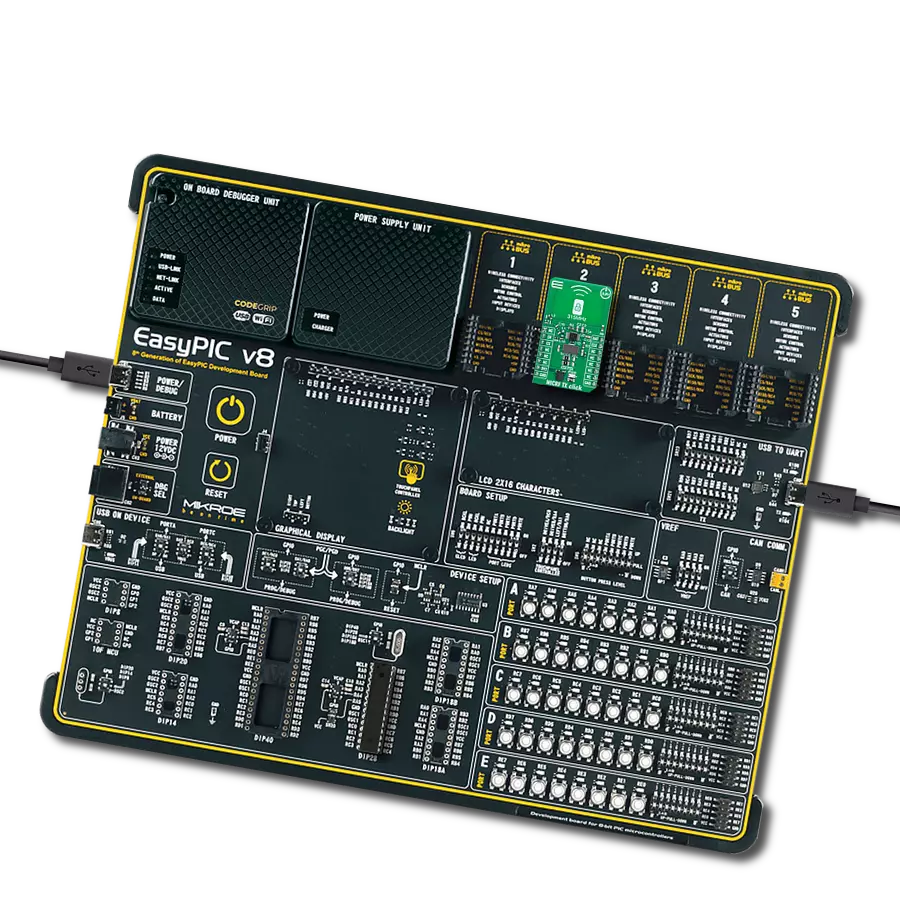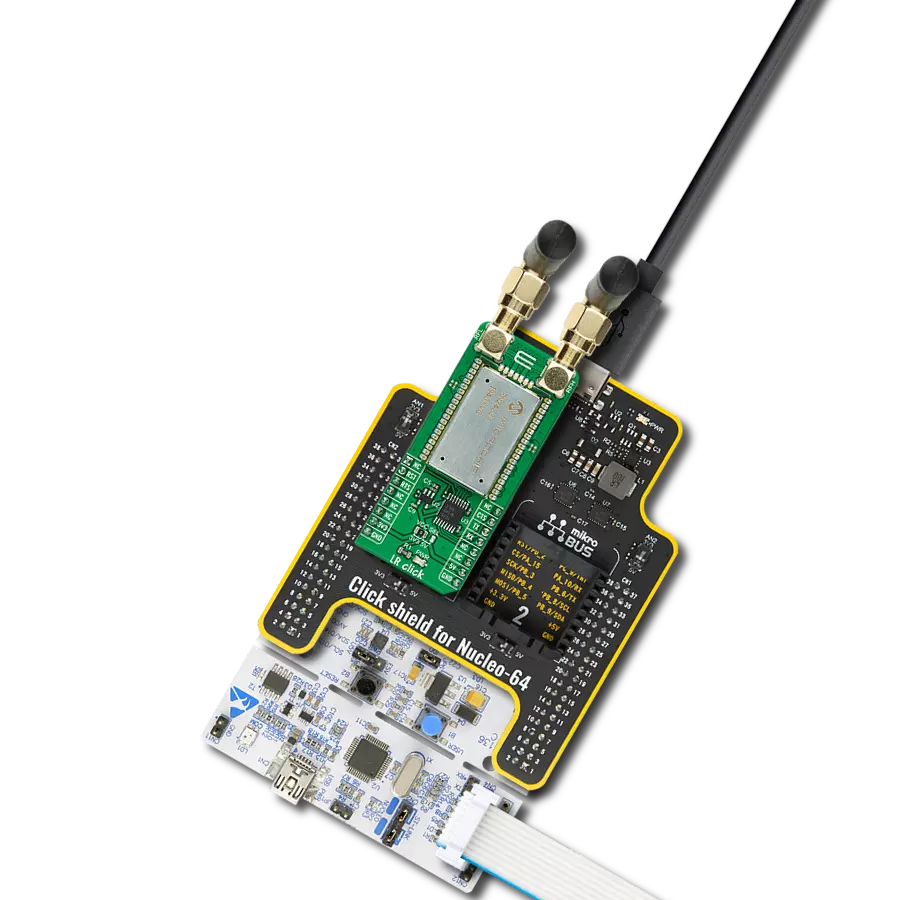Excel in smart metering, home automation, and industrial control applications
A
A
Hardware Overview
How does it work?
M-BUS RF 3 Click is based on the Metis-II (2607021183000), a high-power radio module from Würth Elektronik, operating at 868MHz. This module integrates an MSP430 microcontroller and a CC1125 RF chip-set, offering an efficient and cost-effective communication solution. The Metis-II module adheres to the Wireless M-BUS EN13757-4:2013 standard and supports the Open Metering System (OMS), ensuring wide compatibility in utility metering applications. An increased RF output power of +14dBm and sensitivity up to -106dBm enables reliable wireless communication over distances up to 1000 meters in line-of-sight conditions. Designed with energy efficiency in mind, the module includes low-power functions such as Wake-On-Radio and adjustable RF data rates, making it ideal for long-range, low-power
wireless applications. Additionally, it features AES-128 encryption for secure data transmission, ensuring robust communication for metering systems. Communication between the Metis-II and the host MCU is made through a UART interface, using the standard UART RX and TX pins and hardware flow control pins (CTS/RTS). The module communicates at 115200bps by default, allowing efficient data exchange. The board includes a reset pin (RST) and a RESET button for resetting the module, and two LED indicators for user interaction: an orange TX LED signaling transmission activity and a yellow RX LED indicating reception. In addition to the UART interface, this Click board™ also features a USB Type-C connector, enabling power supply and configuration through a PC. This is made possible
by the CP2102N, a highly integrated USB-to-UART bridge, and the NCP1117 LDO regulator, which converts the USB supply to the required 3.3V for the module allowing for standalone operation. The board is designed to interface with 868MHz antennas, such as the Rubber 868MHz Antenna offered by MIKROE. It includes a u.Fl connector, necessitating an IPEX-SMA cable adapter, also available from MIKROE, to ensure proper antenna connection. This Click board™ can be operated only with a 3.3V logic voltage level. The board must perform appropriate logic voltage level conversion before using MCUs with different logic levels. Also, it comes equipped with a library containing functions and an example code that can be used as a reference for further development.
Features overview
Development board
Nucleo-64 with STM32F410RB MCU offers a cost-effective and adaptable platform for developers to explore new ideas and prototype their designs. This board harnesses the versatility of the STM32 microcontroller, enabling users to select the optimal balance of performance and power consumption for their projects. It accommodates the STM32 microcontroller in the LQFP64 package and includes essential components such as a user LED, which doubles as an ARDUINO® signal, alongside user and reset push-buttons, and a 32.768kHz crystal oscillator for precise timing operations. Designed with expansion and flexibility in mind, the Nucleo-64 board features an ARDUINO® Uno V3 expansion connector and ST morpho extension pin
headers, granting complete access to the STM32's I/Os for comprehensive project integration. Power supply options are adaptable, supporting ST-LINK USB VBUS or external power sources, ensuring adaptability in various development environments. The board also has an on-board ST-LINK debugger/programmer with USB re-enumeration capability, simplifying the programming and debugging process. Moreover, the board is designed to simplify advanced development with its external SMPS for efficient Vcore logic supply, support for USB Device full speed or USB SNK/UFP full speed, and built-in cryptographic features, enhancing both the power efficiency and security of projects. Additional connectivity is
provided through dedicated connectors for external SMPS experimentation, a USB connector for the ST-LINK, and a MIPI® debug connector, expanding the possibilities for hardware interfacing and experimentation. Developers will find extensive support through comprehensive free software libraries and examples, courtesy of the STM32Cube MCU Package. This, combined with compatibility with a wide array of Integrated Development Environments (IDEs), including IAR Embedded Workbench®, MDK-ARM, and STM32CubeIDE, ensures a smooth and efficient development experience, allowing users to fully leverage the capabilities of the Nucleo-64 board in their projects.
Microcontroller Overview
MCU Card / MCU
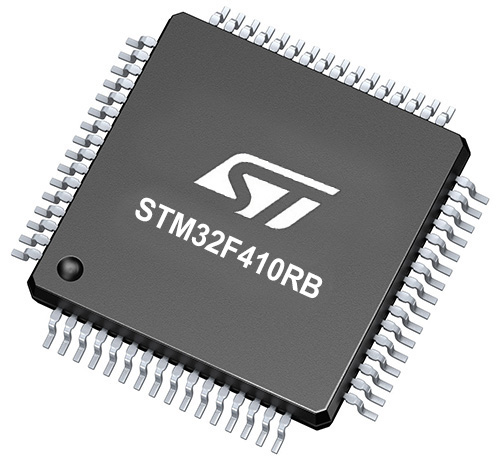
Architecture
ARM Cortex-M4
MCU Memory (KB)
128
Silicon Vendor
STMicroelectronics
Pin count
64
RAM (Bytes)
32768
You complete me!
Accessories
Click Shield for Nucleo-64 comes equipped with two proprietary mikroBUS™ sockets, allowing all the Click board™ devices to be interfaced with the STM32 Nucleo-64 board with no effort. This way, Mikroe allows its users to add any functionality from our ever-growing range of Click boards™, such as WiFi, GSM, GPS, Bluetooth, ZigBee, environmental sensors, LEDs, speech recognition, motor control, movement sensors, and many more. More than 1537 Click boards™, which can be stacked and integrated, are at your disposal. The STM32 Nucleo-64 boards are based on the microcontrollers in 64-pin packages, a 32-bit MCU with an ARM Cortex M4 processor operating at 84MHz, 512Kb Flash, and 96KB SRAM, divided into two regions where the top section represents the ST-Link/V2 debugger and programmer while the bottom section of the board is an actual development board. These boards are controlled and powered conveniently through a USB connection to program and efficiently debug the Nucleo-64 board out of the box, with an additional USB cable connected to the USB mini port on the board. Most of the STM32 microcontroller pins are brought to the IO pins on the left and right edge of the board, which are then connected to two existing mikroBUS™ sockets. This Click Shield also has several switches that perform functions such as selecting the logic levels of analog signals on mikroBUS™ sockets and selecting logic voltage levels of the mikroBUS™ sockets themselves. Besides, the user is offered the possibility of using any Click board™ with the help of existing bidirectional level-shifting voltage translators, regardless of whether the Click board™ operates at a 3.3V or 5V logic voltage level. Once you connect the STM32 Nucleo-64 board with our Click Shield for Nucleo-64, you can access hundreds of Click boards™, working with 3.3V or 5V logic voltage levels.
868MHz right-angle rubber antenna is a compact and versatile solution for wireless communication. Operating within the frequency range of 868-915MHz, it ensures optimal signal reception and transmission. With a 50-ohm impedance, it's compatible with various devices and systems. This antenna boasts a 2dB gain, enhancing signal strength and extending communication range. Its vertical polarization further contributes to signal clarity. Designed to handle up to 50W of input power, it's a robust choice for various applications. Measuring just 48mm in length, this antenna is both discreet and practical. Its SMA male connector ensures a secure and reliable connection to your equipment. Whether you're working with IoT devices, remote sensors, or other wireless technologies, the 868MHz right-angle antenna offers the performance and flexibility you need for seamless communication.
IPEX-SMA cable is a type of RF (radio frequency) cable assembly. "IPEX" refers to the IPEX connector, a miniature coaxial connector commonly used in small electronic devices. "SMA" stands for SubMiniature Version A and is another coaxial connector commonly used in RF applications. An IPEX-SMA cable assembly has an IPEX connector on one end and an SMA connector on the other, allowing it to connect devices or components that use these specific connectors. These cables are often used in applications like WiFi or cellular antennas, GPS modules, and other RF communication systems where a reliable and low-loss connection is required.
Used MCU Pins
mikroBUS™ mapper
Take a closer look
Click board™ Schematic
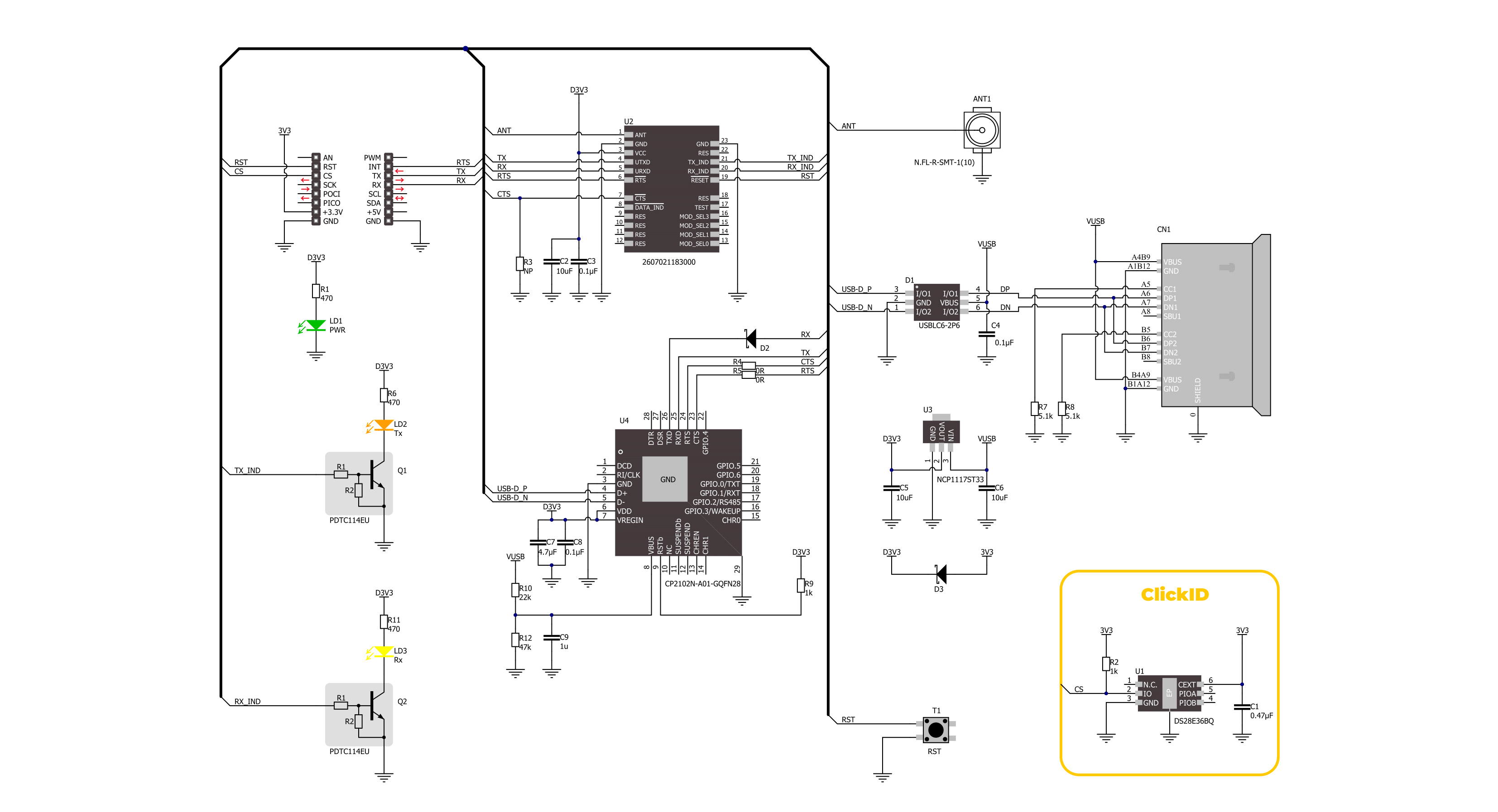
Step by step
Project assembly
Software Support
Library Description
This library contains API for M-BUS RF 3 Click driver.
Key functions:
mbusrf3_set_rst_pin- This function is used to set reset pin state.mbusrf3_send_command- This function is used to send a desired command.mbusrf3_send_data- This function is used to data in transmitter mode.
Open Source
Code example
The complete application code and a ready-to-use project are available through the NECTO Studio Package Manager for direct installation in the NECTO Studio. The application code can also be found on the MIKROE GitHub account.
/*!
* @file main.c
* @brief M-BUS RF 3 Click Example.
*
* # Description
* This example demonstrates the use of M-BUS RF 3 Click board by processing
* the incoming data and displaying them on the USB UART.
*
* The demo application is composed of two sections :
*
* ## Application Init
* Initializes the driver and performs the Click configuration depending on selected DEMO_EXAMPLE macro.
*
* ## Application Task
* This example contains two examples depending on selected DEMO_EXAMPLE macro:
* EXAMPLE_TRANSMIT - Device is sending MESSAGE data to be read by receiver.
* EXAMPLE_RECEIVER - Device is reading transmitted message, and display it on USB UART terminal.
*
* ## Additional Function
* - static void mbusrf3_clear_app_buf ( void )
* - static void mbusrf3_log_app_buf ( void )
* - static err_t mbusrf3_process ( mbusrf3_t *ctx )
* - static err_t mbusrf3_rsp_check ( uint8_t cmd )
* - static void mbusrf3_error_check ( err_t error_flag )
* - static void mbusrf3_configure_for_example ( void )
* - static void mbusrf3_example ( void )
*
* @author Stefan Ilic
*
*/
#include "board.h"
#include "log.h"
#include "mbusrf3.h"
// Example selection macros
#define EXAMPLE_TRANSMIT 0 // Transmit example
#define EXAMPLE_RECEIVER 1 // Reciver example
#define DEMO_EXAMPLE EXAMPLE_TRANSMIT // Example selection macro
// Mode selection macros
#define WM_BUS_MODE_S 0
#define WM_BUS_MODE_T 1
#define WM_BUS_MODE WM_BUS_MODE_S
// Message to be sent
#define MESSAGE "M-BUS RF 3 Click"
// Application buffer size
#define APP_BUFFER_SIZE 500
#define PROCESS_BUFFER_SIZE 200
static mbusrf3_t mbusrf3;
static log_t logger;
static uint8_t app_buf[ APP_BUFFER_SIZE ] = { 0 };
static int32_t app_buf_len = 0;
static err_t error_flag;
/**
* @brief M-BUS RF 3 clearing application buffer.
* @details This function clears memory of application buffer and reset its length.
* @note None.
*/
static void mbusrf3_clear_app_buf ( void );
/**
* @brief M-BUS RF 3 log application buffer.
* @details This function logs data from application buffer to USB UART.
* @note None.
*/
static void mbusrf3_log_app_buf ( void );
/**
* @brief M-BUS RF 3 data reading function.
* @details This function reads data from device and concatenates data to application buffer.
* @param[in] ctx : Click context object.
* See #mbusrf3_t object definition for detailed explanation.
* @return @li @c 0 - Read some data.
* @li @c -1 - Nothing is read.
* See #err_t definition for detailed explanation.
* @note None.
*/
static err_t mbusrf3_process ( void );
/**
* @brief Response check.
* @details This function checks for response and
* returns the status of response.
* @param[in] rsp Expected response.
* @return @li @c 0 - OK response.
* @li @c -1 - Error response.
* @li @c -2 - Timeout error.
* See #err_t definition for detailed explanation.
*/
static err_t mbusrf3_rsp_check ( uint8_t cmd );
/**
* @brief Check for errors.
* @details This function checks for different types of
* errors and logs them on UART or logs the response if no errors occured.
* @param[in] error_flag Error flag to check.
*/
static void mbusrf3_error_check ( err_t error_flag );
/**
* @brief M-BUS RF 3 configure for example function.
* @details This function is used to configure device for example.
*/
static void mbusrf3_configure_for_example ( void );
/**
* @brief M-BUS RF 3 execute example function.
* @details This function executes transmitter or receiver example depending on the DEMO_EXAMPLE macro.
*/
static void mbusrf3_example ( void );
void application_init ( void )
{
log_cfg_t log_cfg; /**< Logger config object. */
mbusrf3_cfg_t mbusrf3_cfg; /**< Click config object. */
/**
* Logger initialization.
* Default baud rate: 115200
* Default log level: LOG_LEVEL_DEBUG
* @note If USB_UART_RX and USB_UART_TX
* are defined as HAL_PIN_NC, you will
* need to define them manually for log to work.
* See @b LOG_MAP_USB_UART macro definition for detailed explanation.
*/
LOG_MAP_USB_UART( log_cfg );
log_init( &logger, &log_cfg );
log_info( &logger, " Application Init " );
// Click initialization.
mbusrf3_cfg_setup( &mbusrf3_cfg );
MBUSRF3_MAP_MIKROBUS( mbusrf3_cfg, MIKROBUS_1 );
if ( UART_ERROR == mbusrf3_init( &mbusrf3, &mbusrf3_cfg ) )
{
log_error( &logger, " Communication init." );
for ( ; ; );
}
mbusrf3_process( );
mbusrf3_clear_app_buf( );
Delay_ms ( 500 );
mbusrf3_configure_for_example( );
log_info( &logger, " Application Task " );
}
void application_task ( void )
{
mbusrf3_example( );
}
int main ( void )
{
/* Do not remove this line or clock might not be set correctly. */
#ifdef PREINIT_SUPPORTED
preinit();
#endif
application_init( );
for ( ; ; )
{
application_task( );
}
return 0;
}
static void mbusrf3_clear_app_buf ( void )
{
memset( app_buf, 0, app_buf_len );
app_buf_len = 0;
}
static void mbusrf3_log_app_buf ( void )
{
for ( int32_t buf_cnt = 0; buf_cnt < app_buf_len; buf_cnt++ )
{
log_printf( &logger, "%c", app_buf[ buf_cnt ] );
}
}
static err_t mbusrf3_process ( void )
{
uint8_t rx_buf[ PROCESS_BUFFER_SIZE ] = { 0 };
int32_t overflow_bytes = 0;
int32_t rx_cnt = 0;
int32_t rx_size = mbusrf3_generic_read( &mbusrf3, rx_buf, PROCESS_BUFFER_SIZE );
if ( ( rx_size > 0 ) && ( rx_size <= APP_BUFFER_SIZE ) )
{
if ( ( app_buf_len + rx_size ) > APP_BUFFER_SIZE )
{
overflow_bytes = ( app_buf_len + rx_size ) - APP_BUFFER_SIZE;
app_buf_len = APP_BUFFER_SIZE - rx_size;
memmove ( app_buf, &app_buf[ overflow_bytes ], app_buf_len );
memset ( &app_buf[ app_buf_len ], 0, overflow_bytes );
}
for ( rx_cnt = 0; rx_cnt < rx_size; rx_cnt++ )
{
if ( rx_buf[ rx_cnt ] )
{
app_buf[ app_buf_len++ ] = rx_buf[ rx_cnt ];
}
}
return MBUSRF3_OK;
}
return MBUSRF3_ERROR;
}
static err_t mbusrf3_rsp_check ( uint8_t cmd )
{
err_t error_flag = MBUSRF3_OK;
uint32_t timeout_cnt = 0;
uint32_t timeout = 120000;
Delay_ms ( 100 );
mbusrf3_clear_app_buf( );
error_flag |= mbusrf3_process( );
while ( MBUSRF3_OK != error_flag )
{
error_flag |= mbusrf3_process( );
if ( timeout_cnt++ > timeout )
{
mbusrf3_clear_app_buf( );
return MBUSRF3_ERROR_TIMEOUT;
}
Delay_ms ( 1 );
}
mbusrf3_process( );
Delay_ms ( 100 );
if ( ( cmd | MBUSRF3_CMD_RESPONSE ) == app_buf[ 1 ] )
{
return MBUSRF3_OK;
}
else
{
return MBUSRF3_ERROR;
}
}
static void mbusrf3_error_check ( err_t error_flag )
{
switch ( error_flag )
{
case MBUSRF3_OK:
{
log_printf( &logger, " OK \r\n" );
break;
}
case MBUSRF3_ERROR:
{
log_error( &logger, " ERROR!" );
break;
}
case MBUSRF3_ERROR_TIMEOUT:
{
log_error( &logger, " Timeout!" );
break;
}
}
log_printf( &logger, " = = = = = = = = = = = = = = = = = \r\n" );
Delay_ms ( 500 );
}
static void mbusrf3_configure_for_example ( void )
{
uint8_t tx_data[ 3 ] = { 0 };
#if ( EXAMPLE_TRANSMIT == DEMO_EXAMPLE )
log_printf( &logger, "Factory reset \r\n" );
mbusrf3_send_command( &mbusrf3, MBUSRF3_CMD_FACTORYRESET_REQ, 0, 0 );
error_flag = mbusrf3_rsp_check( MBUSRF3_CMD_FACTORYRESET_REQ );
mbusrf3_error_check( error_flag );
log_printf( &logger, "Reset device \r\n" );
mbusrf3_send_command( &mbusrf3, MBUSRF3_CMD_RESET_REQ, 0, 0 );
error_flag = mbusrf3_rsp_check( MBUSRF3_CMD_RESET_REQ );
mbusrf3_error_check( error_flag );
#define MODE_MEMORY_INDEX 0x46
#define SET_MODE_LENGTH 0x01
#if ( WM_BUS_MODE_S == WM_BUS_MODE )
log_printf( &logger, "Set mode S1-m \r\n" );
#define S1_METER_ROLE 0x02
tx_data[ 0 ] = MODE_MEMORY_INDEX;
tx_data[ 1 ] = SET_MODE_LENGTH;
tx_data[ 2 ] = S1_METER_ROLE;
mbusrf3_send_command( &mbusrf3, MBUSRF3_CMD_SET_REQ, tx_data, 3 );
error_flag = mbusrf3_rsp_check( MBUSRF3_CMD_SET_REQ );
mbusrf3_error_check( error_flag );
#elif ( WM_BUS_MODE_T == WM_BUS_MODE )
log_printf( &logger, "Set mode T1-meter \r\n" );
#define T1_METER_ROLE 0x05
tx_data[ 0 ] = MODE_MEMORY_INDEX;
tx_data[ 1 ] = SET_MODE_LENGTH;
tx_data[ 2 ] = T1_METER_ROLE;
mbusrf3_send_command( &mbusrf3, MBUSRF3_CMD_SET_REQ, tx_data, 3 );
error_flag = mbusrf3_rsp_check( MBUSRF3_CMD_SET_REQ );
mbusrf3_error_check( error_flag );
#endif
log_printf( &logger, "Reset device \r\n" );
mbusrf3_send_command( &mbusrf3, MBUSRF3_CMD_RESET_REQ, 0, 0 );
error_flag = mbusrf3_rsp_check( MBUSRF3_CMD_RESET_REQ );
mbusrf3_error_check( error_flag );
#elif ( EXAMPLE_RECEIVER == DEMO_EXAMPLE )
log_printf( &logger, "Factory reset \r\n" );
mbusrf3_send_command( &mbusrf3, MBUSRF3_CMD_FACTORYRESET_REQ, 0, 0 );
error_flag = mbusrf3_rsp_check( MBUSRF3_CMD_FACTORYRESET_REQ );
mbusrf3_error_check( error_flag );
log_printf( &logger, "Reset device \r\n" );
mbusrf3_send_command( &mbusrf3, MBUSRF3_CMD_RESET_REQ, 0, 0 );
error_flag = mbusrf3_rsp_check( MBUSRF3_CMD_RESET_REQ );
mbusrf3_error_check( error_flag );
#define EN_CMD_OUT_MEM_INDEX 0x05
#define EN_CMD_OUT_LENGTH 0x01
#define EN_CMD_OUT 0x01
tx_data[ 0 ] = EN_CMD_OUT_MEM_INDEX;
tx_data[ 1 ] = EN_CMD_OUT_LENGTH;
tx_data[ 2 ] = EN_CMD_OUT;
log_printf( &logger, "Enable command output \r\n" );
mbusrf3_send_command( &mbusrf3, MBUSRF3_CMD_SET_REQ, tx_data, 3 );
error_flag = mbusrf3_rsp_check( MBUSRF3_CMD_SET_REQ );
mbusrf3_error_check( error_flag );
#define MODE_MEMORY_INDEX 0x46
#define SET_MODE_LENGTH 0x01
#if ( WM_BUS_MODE_S == WM_BUS_MODE )
log_printf( &logger, "Set mode S2 \r\n" );
#define S2_ROLE 0x03
tx_data[ 0 ] = MODE_MEMORY_INDEX;
tx_data[ 1 ] = SET_MODE_LENGTH;
tx_data[ 2 ] = S2_ROLE;
mbusrf3_send_command( &mbusrf3, MBUSRF3_CMD_SET_REQ, tx_data, 3 );
error_flag = mbusrf3_rsp_check( MBUSRF3_CMD_SET_REQ );
mbusrf3_error_check( error_flag );
#elif ( ( WM_BUS_MODE_C == WM_BUS_MODE ) || ( WM_BUS_MODE_T == WM_BUS_MODE ) )
log_printf( &logger, "Set mode C2 T2 mode \r\n" );
#define C2_T2_MODE 0x09
tx_data[ 0 ] = MODE_MEMORY_INDEX;
tx_data[ 1 ] = SET_MODE_LENGTH;
tx_data[ 2 ] = C2_T2_MODE;
mbusrf3_send_command( &mbusrf3, MBUSRF3_CMD_SET_REQ, tx_data, 3 );
error_flag = mbusrf3_rsp_check( MBUSRF3_CMD_SET_REQ );
mbusrf3_error_check( error_flag );
#endif
log_printf( &logger, "Reset device \r\n" );
mbusrf3_send_command( &mbusrf3, MBUSRF3_CMD_RESET_REQ, 0, 0 );
error_flag = mbusrf3_rsp_check( MBUSRF3_CMD_RESET_REQ );
#else
#error "No demo example selected"
#endif
}
static void mbusrf3_example ( void )
{
#if ( ( EXAMPLE_TRANSMIT == DEMO_EXAMPLE ) )
log_printf( &logger, "Send message \r\n" );
mbusrf3_send_data( &mbusrf3, MESSAGE, strlen( MESSAGE ) );
error_flag = mbusrf3_rsp_check( MBUSRF3_CMD_DATA_REQ );
mbusrf3_error_check( error_flag );
Delay_ms ( 1000 );
#elif ( EXAMPLE_RECEIVER == DEMO_EXAMPLE )
if ( MBUSRF3_OK == mbusrf3_process( ) )
{
Delay_ms ( 100 );
for ( uint8_t buf_cnt = 0; buf_cnt < app_buf[ 2 ]; buf_cnt++ )
{
log_printf( &logger, "%c", app_buf[ buf_cnt + 2 ] );
}
log_printf( &logger, "\r\n" );
mbusrf3_clear_app_buf( );
}
#else
#error "No demo example selected"
#endif
}
// ------------------------------------------------------------------------ END
Additional Support
Resources
Category:Sub-1 GHz Transceievers
